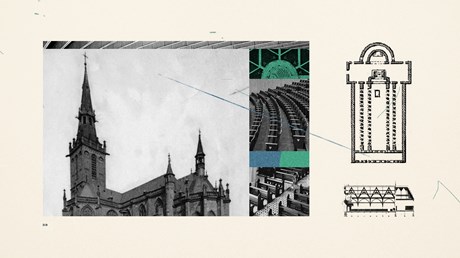How to read what the wood, glass, and stone say about God.

God is bigger than a church building. He reveals himself to us in myriad ways: through the Bible savored in silence or thundered in a sermon, through prayerful solitude or bread broken with others. He reveals himself in the contours of nature and whispers of wind. We do not rely on church buildings for divine encounter.
And yet churches can reveal God to us. If
we pay attention.
As an architect, I am learning how to read buildings. In the same way musicians
must be musically literate, architects must be architecturally literate. A musician must be constantly exposed to a range of compositions to develop musical literacy; an architect must engage all kinds of buildings to be able to read them. This isn’t simply a matter of naming specific styles or noting unique details. It’s learning to understand what statements or narratives are embedded within the design
of a building.
So, I study churches. Church, of course, is a weekly rhythm of small group, choir practice, Bible study, Sunday school, and an inevitable potluck. Church is community and fellowship and belonging. More broadly, there is “one holy, catholic and apostolic church” that spans time and culture. But there are also these buildings that often hide in plain sight.
Embedded in every church is a theology that reminds us of our relationship to God through Christ. If we can learn to read the buildings architecturally, through their elevation, plan, and section, we can grasp what the structures are communicating about God—and, perhaps, what God is communicating to us through these churches.
Elevation
Well before we ever enter a church, we can begin to read its theology simply from its exterior or elevation. An elevation is how a building looks. ...
Continue reading...umn ministry
from Christianity Today Magazine
via


.gif)

.gif)
.gif)
